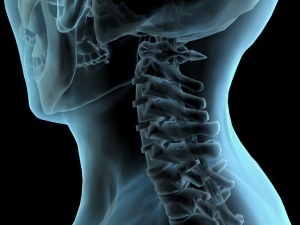Clinical manifestations
Symptoms in cervical osteochondrosis are divided into radicular and reflex.
Reflex Syndrome

Lumbago is characteristic of reflex symptoms. Their main feature is the sudden appearance of a difficult movement, a jerk, or a prolonged presence of the head in one position. A lumbago of the cervical spine literally knocks a person off the track, movements become restricted, the patient assumes a forced position due to severe pain.
Frequent patient complaints:
- constrictive headaches radiating to the temples or baby eyes;
- reduced visual acuity, as if "everything floats" before the eyes;
- possible increase in pressure.
Vertebral artery syndrome occurs when the nerve plexus is irritated, which is often misdiagnosed as a cerebrovascular accident. Manifestations of cervical osteochondrosis with a similar syndrome are frequent dizziness occurring with a sharp turn of the head, almost always accompanied by an uncomfortable feeling of nausea and even vomiting.
It is important to rule out cerebrovascular accidents when making a diagnosis, as the treatment of osteochondrosis is completely different from the treatment of diseases of the vascular system.
With a cardiac symptom at the reflex syndrome clinic in cervical osteochondrosis, the patient is characterized by sensations resembling an attack of angina pectoris, but difficulties in accurately diagnosing the disease are usually not noticed, as a cardiac symptom is accompanied bynumber of symptoms characteristic of osteochondrosis of the spine.
Radicular Syndrome
Signs of cervical osteochondrosis in radicular syndrome appear in direct proportion to the "number" of the compressed nerve.
Symptoms, sensory and motor changes depend on which nerve root is affected:
- C1- there is a sensitivity violation in the occupational region;
- C2- the patient feels pain in the parietal and occipital regions;
- C3- pain appears in the half of the neck where the violation occurred. Symptoms: decreased sensitivity, dysfunction and touch of the tongue, speech disorders;
- C4- has pain in the shoulder-shoulder region, impaired sensitivity, may damage the heart and liver;
- C5- the patient does not feel the shoulder well on its outer surface, worries about pain in this area;
- C6- pain in osteochondrosis at the level of the 6th vertebra extends to the forearm, shoulder, radial surface and "descends" to the thumb;
- C7- pain "spreads" from the neck to the shoulder blade, passes along the back of the shoulder and forearm, goes to 2-4 fingers, sensitivity in this area worsens;
- C8- pain is localized from the neck to the shoulder and further to the little finger.
Inseparable pathological connection

VSD and cervical osteochondrosis are closely related, and vegetative-vascular dystonia may occur as a result of damage to the cartilage of the cervical joint, which liberates the human nervous system. Dystonia and osteochondrosis, detected at the same time, can be a common disease or VSD occurs for common reasons.
Osteochondrosis is one of the factors that provokes VSD, but it is not necessary for the latter to follow the former. Vegetative-vascular dystonia often occurs in various types of osteochondrosis, especially in disorders of the cervical spine. But it can also occur as a result of injury, pressure on the nerves in the cervical spine occurs, blood flow deteriorates and the pressure inside the skull increases.Diagnostic Errors
VSD, osteochondrosis and thoracic pain are treated in different ways. Expensive (and often unnecessary) tests show nothing but problems in the cervical region and concerns in the work of blood vessels. In this case, the treatment often remains the same - heart complexes, vitamins, antidepressants. Chiropractors eliminate pain, put the patient in an optimistic mood, but panic attacks, stress and fatigue go nowhere.
More and more people are falling victim to inappropriate therapy, panic attacks (or a VSD attack) are becoming almost the norm for them, but still, many patients prefer self-medication or visiting "doctors" activities. who do not intend to get rid of the disease, only for the enrichment of themselves.
Characteristic manifestation groups
The main clinical signs of cervical osteochondrosis can be divided into several groups:

- first.Neurological symptoms arise as a result of complications in cervical osteochondrosis and with direct pressure on the nerve roots, nerve plexuses;
- seconds.Symptoms appear when they directly affect the spinal cord;
- i treti.Symptoms arise in the brain, affecting its vessels, structures, membranes and trunk.
Each of the listed groups has its own clinical signs and pattern of manifestations, but there is a similarity of symptoms, thanks to which it is possible to make an accurate diagnosis.
Symptoms of cervical vertebral osteochondrosis often appear as a neurological complication, a characteristic feature of which is pain in the shoulder joint. This pathology is called "shoulder shoulder periarthritis".
The distinguishing features of spinal cord compression in the cervical region are volumetric tissue damage and a strong decline in important functions. Sensitivity of the skin and muscles is impaired, paresis develops and in complex pathological cases, paralysis.
This is why, even at the first suspicion of cervical osteochondrosis, it is important to visit a specialist, perform the necessary diagnostic measures, and undergo a course of treatment. Remember that pathology detected in time is eliminated quickly and without consequences.



































